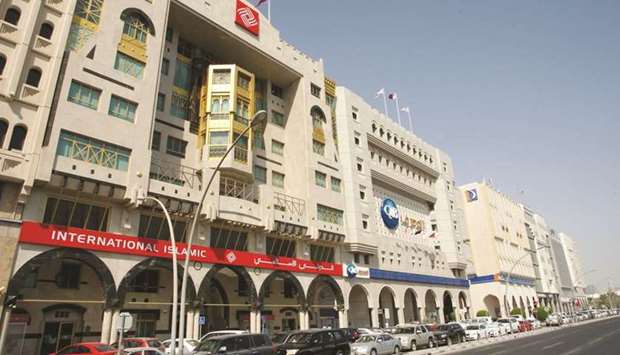Qatar banks – whose core earnings defy gravity, offsetting pandemic spike in credit costs – are expected to show profit resiliency this year on higher efficiency, solid capital buffers and resolution to the Gulf crisis, according to Moody's, the international credit rating agency.
The banks improved their operating efficiency in 2020 through cost control measures such as reducing staff and travel expenses, which eased the pressure on their bottom-line profit, Moody's said in a report.
Finding that the operating expenses fell 6% year-on-year to QR11.1bn, while cost-to-income ratio fell to 25% from 28%; it said "we expect this trend to continue as the full impact of cost-control measures in 2020 will become evident by the end of 2021."
Although the banks' provisioning increased to QR10.4bn in 2020 from QR6bn in 2019, and consumed around 32% of pre-provision income against 20% previously, it said actions taken to contain the pandemic, the global economic shock and low oil prices weighed on economic growth and borrowers’ repayment capacity.
Most of the increase in provisioning charges in 2020 was because of a rise in expected credit losses in the Stage-3 bucket of the banks’ corporate book, it said, adding however, loan quality had remained relatively stable: the problem loan-to-gross loans ratio increased marginally to 2% as of December 2020 from 1.9% as of December 2019.
Highlighting that most of the banks have taken loan-loss provisions as a precautionary measure to account for a potential deterioration in loan quality, Moody's said it expected the bulk of problem loans to emerge in sectors that are more exposed to the pandemic's effects, such as hotels and restaurants, airlines, tourism and retail.
Expecting only a limited further deterioration in loan quality in 2021; the rating agency said banks' lending books are heavily skewed toward government or government-related entities, which accounted for 31% of total loans as of December 2020.
The retail exposure is mainly to Qatari nationals, who have experienced negligible job losses, while the realty market has seen in a cooling-off period for the past few years and new lending to the sector has been relatively limited.
"Together, these factors will limit the increase in provisioning costs, limiting the potential downside for the banks' profitability," Moody's said.
The banks preserved their capital buffers in 2020, supported by lower dividend payout ratios and strong earnings, it said, adding the aggregate tangible common equity to risk-weighted assets ratio remained unchanged at 15.1% as of December 2020 compared with December 2019.
Moody's said solid capital buffers, current oil prices and the resolution of Qatar's diplomatic dispute with its neighbours will support banks' financial performance in 2021 amid deteriorating loan quality because of the pandemic.
Unlike the regional peers, Qatari banks' total income rose 4% to QR43.9bn in 2020 with the rise coming despite an 11% decline in non-interest income, which was offset by 9% jump in net interest income.
Net interest margins remained "stable" at a healthy 2.1% despite compressed asset yields in the current environment, it said, adding "we expect total income to remain subdued in 2021 because of lower business volumes."
The banks’ return on assets was "strong" at 1.2% in 2020, down from 1.4% in 2019 because of higher coronavirus-related provisions and 7% year-over-year growth in tangible banking assets. Higher credit costs were partly offset by higher revenue and improved efficiency, it said.
The banks improved their operating efficiency in 2020 through cost control measures such as reducing staff and travel expenses, which eased the pressure on their bottom-line profit, Moody's said in a report.
Finding that the operating expenses fell 6% year-on-year to QR11.1bn, while cost-to-income ratio fell to 25% from 28%; it said "we expect this trend to continue as the full impact of cost-control measures in 2020 will become evident by the end of 2021."
Although the banks' provisioning increased to QR10.4bn in 2020 from QR6bn in 2019, and consumed around 32% of pre-provision income against 20% previously, it said actions taken to contain the pandemic, the global economic shock and low oil prices weighed on economic growth and borrowers’ repayment capacity.
Most of the increase in provisioning charges in 2020 was because of a rise in expected credit losses in the Stage-3 bucket of the banks’ corporate book, it said, adding however, loan quality had remained relatively stable: the problem loan-to-gross loans ratio increased marginally to 2% as of December 2020 from 1.9% as of December 2019.
Highlighting that most of the banks have taken loan-loss provisions as a precautionary measure to account for a potential deterioration in loan quality, Moody's said it expected the bulk of problem loans to emerge in sectors that are more exposed to the pandemic's effects, such as hotels and restaurants, airlines, tourism and retail.
Expecting only a limited further deterioration in loan quality in 2021; the rating agency said banks' lending books are heavily skewed toward government or government-related entities, which accounted for 31% of total loans as of December 2020.
The retail exposure is mainly to Qatari nationals, who have experienced negligible job losses, while the realty market has seen in a cooling-off period for the past few years and new lending to the sector has been relatively limited.
"Together, these factors will limit the increase in provisioning costs, limiting the potential downside for the banks' profitability," Moody's said.
The banks preserved their capital buffers in 2020, supported by lower dividend payout ratios and strong earnings, it said, adding the aggregate tangible common equity to risk-weighted assets ratio remained unchanged at 15.1% as of December 2020 compared with December 2019.
Moody's said solid capital buffers, current oil prices and the resolution of Qatar's diplomatic dispute with its neighbours will support banks' financial performance in 2021 amid deteriorating loan quality because of the pandemic.
Unlike the regional peers, Qatari banks' total income rose 4% to QR43.9bn in 2020 with the rise coming despite an 11% decline in non-interest income, which was offset by 9% jump in net interest income.
Net interest margins remained "stable" at a healthy 2.1% despite compressed asset yields in the current environment, it said, adding "we expect total income to remain subdued in 2021 because of lower business volumes."
The banks’ return on assets was "strong" at 1.2% in 2020, down from 1.4% in 2019 because of higher coronavirus-related provisions and 7% year-over-year growth in tangible banking assets. Higher credit costs were partly offset by higher revenue and improved efficiency, it said.




